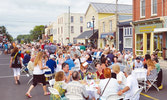CCRC sets new goals for program
By Shawn Loughlin
With the transition from Arts and Cultural Initiative 14/19 to the Canadian Centre for Rural Creativity (CCRC) well underway, Project Manager Peter Smith has some lofty goals going forward.
News was released in The Citizen several weeks ago that the transition was officially underway, with the first goal of 14/19 – the renovation of Memorial Hall – now complete. With the former Blyth Public School property now up for sale, however, the location of the centre is yet to be determined, though a number of locations are currently being considered.
Smith says that it made sense to sell the property and look elsewhere for a location for the Grant and Mildred Sparling Centre, which will house the CCRC in the future. The hope, he said, is that the project can take cues and attract input from the entire community and that a support structure can be built around the centre, possibly including accommodation options and other amenities.
With the search for a new location, Smith says, comes an opportunity to look at the project with fresh eyes and reshape its future to see what it can become.
Smith says the CCRC is still working with renowned architect Heather Dubbeldam for the design of the centre; the project is just waiting for a new location to be confirmed.
In the meantime, however, Smith said that much of what is planned for the coming years can be accomplished without the aid of a bricks and mortar facility.
The CCRC is in the midst of fundraising to host another Fare on 4 meal to bookend the meal that fed 1,419 people on Blyth’s main street in 2014 to kick off the 14/19 campaign.
Smith says he feels it would be rather poetic to host another Fare on 4 in 2019. Right now, nothing has been confirmed, but the CCRC is looking at Sunday, July 21 as a potential date.
There have also been discussions, Smith said, about turning Fare on 4 into a biennial event, joining the organization’s Rural Talks to Rural (R2R) conferences and perhaps alternating them so the CCRC has one of its flagship events every year.
The second project Smith and the CCRC are currently working on is the National Policy Creative, which is an adaptation of a program currently in place in Holland that works to advise federal decision-makers.
The concept comes to the CCRC straight from Hans van der Loo, who was a speaker at the 2018 R2R conference, delivering the opening keynote presentation, entitled “Wake Up: This is (Y)Our Only Home”. Van der Loo is involved in a number of initiatives in Europe and has been able to connect Smith to the Dutch think tank that has inspired the concept.
Smith says that every year in Holland since 2005, a group of 20 scholars, recent graduates and other intellectuals get together to brainstorm better policy for the country. The statistics show, Smith said, that many of the recommendations made by the group over the last nearly 15 years have been adopted and made into federal policy.
Smith says he’s very excited by the possibilities of a similar collective in Canada. It would be adapted, however, to fit the CCRC model and the infrastructure already in place in Blyth, bringing in artists and creative residents, as well as critical thinkers, into the fold in the hopes of affecting change in the country.
Whether it’s research and development, the creation of surveys or a number of other concepts, the collective in Holland has proven its worth and Smith hopes that a similar model could do the same for Canada and its federal government.
In May, Smith will be travelling to Ottawa in the hopes of drumming up support for the program with an aim of getting it off the ground very soon.
Smith says that there are over 100 universities in Canada and harnessing that intelligence and creative thinking will be crucial to the success of this project.
The third project the centre is currently at work on is “Rurality”, an app that will aim to connect those in rural and remote communities across Canada.
Again, the idea grew out of last fall’s R2R conference and Huron-Bruce federal Liberal candidate Allan Thompson’s Market Street Strategies and how they worked to broadcast the goings-on of R2R to the world.
The app, Smith says, would cost the centre a fair bit of money, so it may take time, but he says it’s a great concept that could really have a place in the CCRC’s work going forward.
Smith said that while things with the CCRC are changing and it’s in a period of transition from 14/19 to the centre itself, it is an exciting time and one that’s filled with potential and possibility.
Steven Sparling of 14/19 agrees, saying it’s an exciting time for the village and for the future of the CCRC. While the physical location of the centre is currently in transition, he feels there are a lot of positive possibilities for the centre in its future.
When the opportunity to sell the land along King Street in Blyth, the former home of Blyth Public School, came along, Sparling said it made sense to find a new home for the CCRC.
When 14/19 was launched, it made sense to work to locate the CCRC on a site that had served as a learning centre for Blythites for decades through Blyth Public School, Sparling said. A lot has happened in the last five years, he said, and the centre doesn’t necessarily need to be at that location to be successful.
Part of that successful future is a fundraising campaign that Smith has undertaken, working to raise $6,000 to help fund the centre’s work in the coming months. At press time, Smith was over halfway to his stated goal, but still requires help.
To donate to the CCRC, visit www.ulule.com/ruralfuture/ and for more information on the centre, visit ruralcreativity.org.




